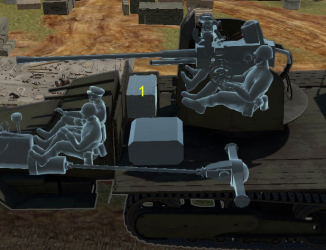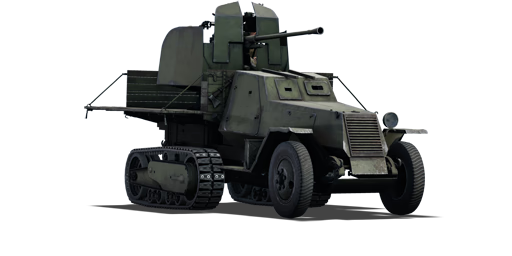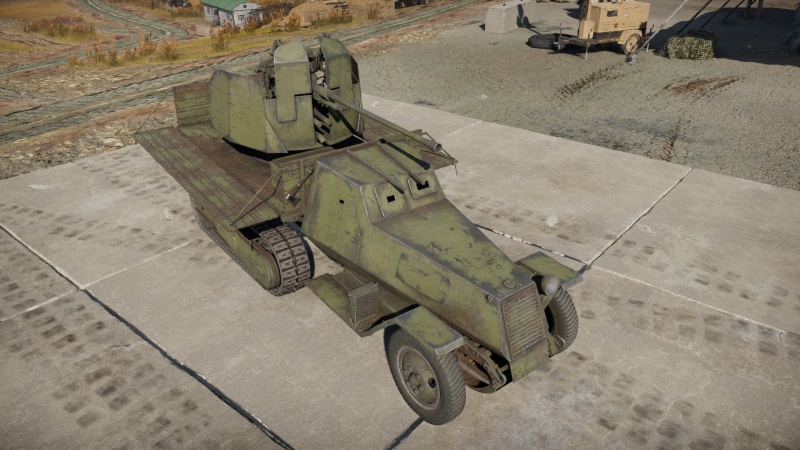Difference between revisions of "ZiS-43"
m (→See also) |
(added missing info) (Tag: Visual edit) |
||
| Line 14: | Line 14: | ||
If necessary use a visual template to indicate the most secure and weak zones of the armour.--> | If necessary use a visual template to indicate the most secure and weak zones of the armour.--> | ||
| + | The ZiS-43 is inexistant and can barely withstand 12.7mm machine gun fire. Thus, as the rest of SPAA in the game, it is really fragile and should not be relied on armor, every plane is a threat that has to be taken seriously as the turret is open and has a small 15mm shield which barely provides protection to 7.62mm machine gun fire. Almost all bomb fragmentation is able to penetrate and damage crew members. Some bombs, depending on the explosion power and fragmentation radious as well as distance bewteen bomb and the ZiS-43, may not kill crew members. However they will often damage them and let them in a yellow-orange status. | ||
| + | |||
'''Armour type:''' | '''Armour type:''' | ||
| Line 40: | Line 42: | ||
<!-- ''Write about the mobility of the ground vehicle. Estimate the specific power and manoeuvrability, as well as the maximum speed forwards and backwards.'' --> | <!-- ''Write about the mobility of the ground vehicle. Estimate the specific power and manoeuvrability, as well as the maximum speed forwards and backwards.'' --> | ||
| − | {{tankMobility|abMinHp= 128|rbMinHp= 80|<!--AoAweight=(optional) -->}} | + | {{tankMobility|abMinHp= 128|rbMinHp= 80|<!--AoAweight=(optional) -->}}Similar to the [[M16 MGMC|M16]] SPAA, being a halftrack is a mid-point between wheel speed and track traction. It is far from being the fastest halftrack in game. However, it does provide increased traction when it comes to rough terrain, is not comparable to full tracked vehicles but is better than fully wheeled vehicles seen at the battle-rating. Being a halftrack leaves it with a "semi tank turn" capacity, meaning tracks are able to help steer but will not do so completely as the steering is given from the frontal wheels. |
=== Modifications and economy === | === Modifications and economy === | ||
| Line 50: | Line 52: | ||
{{Specs-Tank-Weapon|1}} | {{Specs-Tank-Weapon|1}} | ||
<!--Give the reader information about the characteristics of the main gun. Assess its effectiveness in a battle based on the reloading speed, ballistics and the power of shells. Do not forget about the flexibility of the fire, that is how quickly the cannon can be aimed at the target, open fire on it and aim at another enemy. Add a link to the main article on the gun: <code><nowiki>{{main|Name of the weapon}}</nowiki></code>. Describe in general terms the ammunition available for the main gun. Give advice on how to use them and how to fill the ammunition storage.--> | <!--Give the reader information about the characteristics of the main gun. Assess its effectiveness in a battle based on the reloading speed, ballistics and the power of shells. Do not forget about the flexibility of the fire, that is how quickly the cannon can be aimed at the target, open fire on it and aim at another enemy. Add a link to the main article on the gun: <code><nowiki>{{main|Name of the weapon}}</nowiki></code>. Describe in general terms the ammunition available for the main gun. Give advice on how to use them and how to fill the ammunition storage.--> | ||
| − | {{main|61-K (37 mm)}} | + | {{main|61-K (37 mm)}}The ZiS-43 is armed with a quick firing 37mm which is more than capable to deal with both aircraft and ground targets. Since it has a slow traverse speed, it is tricky to aim with the ZiS-43 when it comes to short distances between aircraft and SPAA. This can be countered by engaging enemy aircraft at distances. However, this is a game changer when it comes to ground fight. Turret rotation speed is the difference between life or death for various reasons: exposed crew, not being able to counterattack quickly, tank traverse is painfully slow. |
{| class="wikitable" style="text-align:center" width="100%" | {| class="wikitable" style="text-align:center" width="100%" | ||
| Line 129: | Line 131: | ||
<!--Describe the tactics of playing in the vehicle, the features of using vehicles in the team and advice on tactics. Refrain from creating a "guide" - do not impose a single point of view but instead give the reader food for thought. Describe the most dangerous enemies and give recommendations on fighting them. If necessary, note the specifics of the game in different modes (AB, RB, SB).--> | <!--Describe the tactics of playing in the vehicle, the features of using vehicles in the team and advice on tactics. Refrain from creating a "guide" - do not impose a single point of view but instead give the reader food for thought. Describe the most dangerous enemies and give recommendations on fighting them. If necessary, note the specifics of the game in different modes (AB, RB, SB).--> | ||
| − | Despite the vehicle potent armament, it is not built for direct front-line combat. It is poorly armoured, tall, slow and unstable. If necessary, it is possible to penetrate most vehicles sides or rear but sticking to anti-aircraft duty will yield the best results. Do not stay in spawn however, most planes will attack your teammates busy fighting instead of you. | + | Despite the vehicle potent armament, it is not built for direct front-line combat. It is poorly armoured, tall, slow and unstable. If necessary, it is possible to penetrate most vehicles sides or rear but sticking to anti-aircraft duty will yield the best results. Do not stay in spawn however, most planes will attack your teammates busy fighting instead of you. Similar to previous seen SPAA, they have really good capabilities for both anti-air and anti-ground duties. However, despite being a higher caliber than the previously seen 25mm and 14.5mm, it lacks the ROF to engage targets ''as fast'' as the other SPAA's. |
=== Pros and cons === | === Pros and cons === | ||
| Line 189: | Line 191: | ||
* ''reference to the series of the vehicles;'' | * ''reference to the series of the vehicles;'' | ||
* ''links to approximate analogues of other nations and research trees.''--> | * ''links to approximate analogues of other nations and research trees.''--> | ||
| + | |||
;Other vehicles of similar configuration and role | ;Other vehicles of similar configuration and role | ||
| + | |||
* [[Sd.Kfz. 6/2]] | * [[Sd.Kfz. 6/2]] | ||
* [[CCKW 353 AA]] | * [[CCKW 353 AA]] | ||
| Line 201: | Line 205: | ||
* [https://warthunder.com/en/news/4383-development-zis-43-when-you-need-a-bigger-bang-en/ [Devblog<nowiki>]</nowiki> ZiS-43: When You Need a Bigger Bang] | * [https://warthunder.com/en/news/4383-development-zis-43-when-you-need-a-bigger-bang-en/ [Devblog<nowiki>]</nowiki> ZiS-43: When You Need a Bigger Bang] | ||
| − | * | + | * https://warspot.net/124-halftrack-experiments - Halftrack Experiments on warspot.net |
{{USSR anti-aircraft vehicles}} | {{USSR anti-aircraft vehicles}} | ||
Revision as of 17:30, 22 February 2021
Contents
Description
The ZiS-43 is a rank II Soviet self-propelled anti-aircraft vehicle with a battle rating of 4.0 (AB) and 2.7 (RB/SB). This SPAAG was introduced in Update 1.65 "Way of the Samurai". A 37 mm cannon placed in an anti-aircraft turret on a ZiS-42M half-track chassis, the ZIS-43 was a prototype built in November 1942 which underwent testing but never entered production.
General info
Survivability and armour
The ZiS-43 is inexistant and can barely withstand 12.7mm machine gun fire. Thus, as the rest of SPAA in the game, it is really fragile and should not be relied on armor, every plane is a threat that has to be taken seriously as the turret is open and has a small 15mm shield which barely provides protection to 7.62mm machine gun fire. Almost all bomb fragmentation is able to penetrate and damage crew members. Some bombs, depending on the explosion power and fragmentation radious as well as distance bewteen bomb and the ZiS-43, may not kill crew members. However they will often damage them and let them in a yellow-orange status.
Armour type:
- Rolled homogeneous armour
- Structural steel (Gun mount)
- Wood (Truck bed)
| Armour | Front | Sides | Rear | Roof |
|---|---|---|---|---|
| Driver's cabin | 10 mm (20-82°) 7.5 mm Hatches and Doors |
10 mm (14-27°) | 10 mm (6°) | 10 mm |
| Turret | 15 mm (2-32°) | 10 mm (4-6°) | N/A | N/A |
| Cargo bed | 10 mm | 10 mm | 10 mm | 10 mm |
Notes:
- Suspension wheels are 15 mm thick, tracks are 7 mm, wheels are 2 mm thick.
- Due to the vehicle hurried construction, it is mostly a patchwork of 10mm steel plates welded onto the underlying chassis.
- The turret crew have their heads visible from the front and sides. They are fully exposed in the rear and above.
Mobility
| Game Mode | Max Speed (km/h) | Weight (tons) | Engine power (horsepower) | Power-to-weight ratio (hp/ton) | |||
|---|---|---|---|---|---|---|---|
| Forward | Reverse | Stock | Upgraded | Stock | Upgraded | ||
| Arcade | 39 | 9 | 8.7 | 128 | 172 | 14.71 | 19.77 |
| Realistic | 35 | 9 | 80 | 90 | 9.2 | 10.34 | |
Modifications and economy
Armaments
Main armament
| 37 mm 61-K (x1) | Turret rotation speed (°/s) | Reloading rate (seconds) | ||||||||||||
|---|---|---|---|---|---|---|---|---|---|---|---|---|---|---|
| Mode | Capacity (Belt) | Fire rate | Vertical | Horizontal | Stabilizer | Stock | Upgraded | Full | Expert | Aced | Stock | Full | Expert | Aced |
| Arcade | 260 (5) | 160 | -5°/+85° | ±180° | N/A | 26.5 | 36.6 | 44.4 | 49.1 | 52.2 | 0.65 | 0.58 | 0.53 | 0.50 |
| Realistic | 17.9 | 21.0 | 25.5 | 28.2 | 30.0 | |||||||||
Ammunition
- Default: AP-T · HEFI-T* - These rounds work well until the others are researched and offer the same performance as both other belts to the detriment of a halfed rate of fire.
- UO-167: HEFI-T* - These are absolutely devastating in the AA role.
- BR-167: AP-T · HEFI-T* - These are best against enemy tanks at close range and do good damage to planes.
Since every bullet is a tracer, firing makes you easily detected by enemy airplanes and tanks.
| Penetration statistics | |||||||
|---|---|---|---|---|---|---|---|
| Ammunition | Type of warhead |
Penetration @ 0° Angle of Attack (mm) | |||||
| 10 m | 100 m | 500 m | 1,000 m | 1,500 m | 2,000 m | ||
| Default | AP-T/HEFI-T* | 71 | 68 | 57 | 46 | 37 | 30 |
| UO-167 | HEFI-T* | 3 | 3 | 3 | 3 | 3 | 3 |
| BR-167 | AP-T | 71 | 68 | 57 | 46 | 37 | 30 |
| Shell details | |||||||||
|---|---|---|---|---|---|---|---|---|---|
| Ammunition | Type of warhead |
Velocity (m/s) |
Projectile Mass (kg) |
Fuse delay (m) |
Fuse sensitivity (mm) |
Explosive Mass (TNT equivalent) (g) |
Ricochet | ||
| 0% | 50% | 100% | |||||||
| UO-167 | HEFI-T* | 866 | 0.74 | 0.0 | 0.1 | 34 | 79° | 80° | 81° |
| BR-167 | AP-T | 880 | 0.76 | N/A | N/A | N/A | 47° | 60° | 65° |
Ammo racks

| Full ammo |
1st rack empty |
Visual discrepancy |
|---|---|---|
| 52 | 1 (+51) | No |
The ammunition is modeled as a single big box containing clips.
Usage in battles
Despite the vehicle potent armament, it is not built for direct front-line combat. It is poorly armoured, tall, slow and unstable. If necessary, it is possible to penetrate most vehicles sides or rear but sticking to anti-aircraft duty will yield the best results. Do not stay in spawn however, most planes will attack your teammates busy fighting instead of you. Similar to previous seen SPAA, they have really good capabilities for both anti-air and anti-ground duties. However, despite being a higher caliber than the previously seen 25mm and 14.5mm, it lacks the ROF to engage targets as fast as the other SPAA's.
Pros and cons
Pros:
- 37 mm is deadly to anything it penetrates, planes or tanks
- The gun is able to shoot targets directly in front of the vehicle, unlike some of the previous AA trucks
- Most vehicles can be engaged at close range if needed
- Low armour means APHE won't always fuze
- Most light machine guns will struggle to penetrate
- Fairly high penetration (70 mm)
- Full turret rotation
- Driver and commander are protected in an enclosed driving compartment, which is well protected against small calibre machine gun rounds
- Four crew members allow you to continue with only two after taking damage
- Half-track mount gives better cross-country movement than previous trucks
Cons:
- Thin-skinned vehicle, HE rounds will destroy it
- Very tall for self-propelled anti-aircraft vehicle
- Slow fire rate allows planes to fly between shots
- Open turret configuration, open to machine gun fire
- High recoil causes the entire chassis to wobble, making continuous fire extremely inaccurate
- Sluggish maneuverability
- Extremely vulnerable to 12.7 mm machine guns
- Slow turret traverse
- Needs to move forward in order to turn
- Armour protection is not sufficient to stop aircraft fire
- Vulnerable to artillery strikes
- Can be hull-broken
- Has a rather unusual tendency to wobble side-to-side when driving, making it harder to fire on the move
History
The GAU (Russian: Главное артиллерийское управление, English: Main Artillery Directorate) set forth a requirement for an anti-aircraft vehicle using a 37 mm AA gun on a ZiS-42 half-track on 14 November 1942. The requirements stated that it was to have armor protection for the engine and cabin, and also was to have an armored shield for the gun mount. The requirements also gave a maximum weight of 6.5 tons; the vehicle was developed by the ZiS factory in Moscow and was given the designation ZiS-43.
The ZiS-43 utilized the ZiS-42M half-track chassis with a 37 mm 61-K anti-aircraft gun mounted on the flat bed at the rear. The front half of the weapon mount was protected by armored shields, the engine compartment was uparmored, and so was the cabin. All the added armor protection gave the vehicle a weight of 8.75 metric tons. In addition to the weapon system and increased armor, the vehicle included other minor changes in comparison to the ZiS-42 including redesigned grills for increased engine cooling. The sides, as well as the top, of the engine compartment received armored hatches for ease of maintenance. The cabin was redesigned in order to give the driver more comfortable working conditions, as on other models the driver’s position was known to be incredibly uncomfortable.
The prototype went to trials on 15 December 1942 after driving 380 kilometers to Gorohovets Artillery Proving Grounds from the factory. From the 19th to the 23rd of December, the ZiS-43 prototype was driven over five hundred kilometers. Problems arose with the cooling of the vehicle, with the engine overheating twice during trials and the cabin getting as hot as 50°C. Due to the weight of the ZiS-43, a maximum speed of 35 kph was achieved on roads and only 19.5 kph on dirt roads. The average speed was 29.3 kph on roads and the fuel consumption was as high as 110 liters per 100 kilometers on dirt roads and still a low minimum of 90 liters per 100 kilometers on more favorable terrain. During firing trials a number of other issues were revealed; the headlights would shatter upon firing due to changes in pressure and the high center of gravity caused accuracy issues due to instability.
The ZiS-43 never entered service thanks to its disappointing performance during trials, leaving production at only one prototype. For an anti-aircraft vehicle such armor was seen as an unnecessary burden, and the program was subsequently cancelled. After the cancellation of the program the armor of the ZiS-43 prototype was removed, returning it to its original state as a ZiS-42M.
Media
- Skins
- Videos
See also
- Other vehicles of similar configuration and role
External links
- [Devblog] ZiS-43: When You Need a Bigger Bang
- https://warspot.net/124-halftrack-experiments - Halftrack Experiments on warspot.net
| USSR anti-aircraft vehicles | |
|---|---|
| GAZ-AAA | GAZ-AAA (4M) · GAZ-AAA (DShK) |
| BTR-152 | BTR-152A · BTR-152D |
| Wheeled/Half-tracked | GAZ-MM (72-K) · ZiS-12 (94-KM) · ZiS-43 |
| Radar SPAAG | ZSU-23-4 · ZSU-37-2 |
| SAM | ZSU-23-4M4 · Strela-10M2 · 2S6 · Pantsir-S1 |
| Other | ZSU-23-4M2 · ZUT-37 · ZSU-37 · BTR-ZD · ZSU-57-2 |
| Czechoslovakia | M53/59 |
| North Vietnam | ▂Phòng không T-34 |





